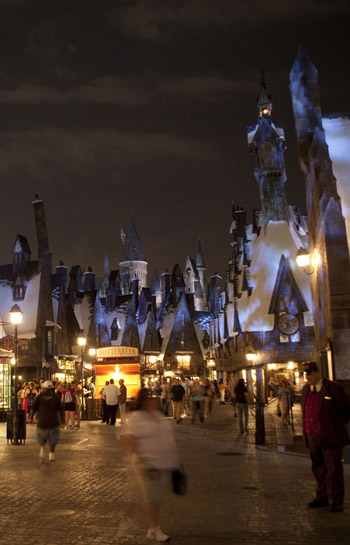WHAT LANDSCAPE ARCHITECTS CAN LEARN FROM HOLLYWOOD
Hollywood studio backlots in southern California have been used to build whole worlds for the big screen for decades. While technologies have changed over time, the principles set designers use to create movie magic seems to be largely the same. Chip Sullivan, ASLA, a professor of landscape architecture at the University of California at Berkeley, author, and self-professed wanna-be film director, revealed how they do it and what landscape architects can learn from their approach at the ASLA 2015 Annual Meeting in Chicago. Why learn from Hollywood? Because they are “creating the landscapes we all want to be in.”
Classic Hollywood set designs have created:
An Illusion of Depth
Movie set designers have long used visual tricks to create an “illusion of depth.” In the beginning of the 20th century, George Melies, one of the first “screen magicians,” would create matte background paintings on glass. And in the following decades, background paintings were continued to be used to create fake scenery. The first 10 feet was reserved for actors and objects, whereas the rest was just painting. The way you can tell, said Sullivan, is that the camera angle would shift every 2 seconds. This is because at “3 seconds, we can detect a fake.” Still, these elaborate set paintings received the “same amount of effort as Renaissance paintings.”
For popular mid-century films set on the South Seas, designers even transformed a Southern Californian backlot into an oceanic scene. To achieve this effect, they would dam a creek and use huge mirrors to create an infinite landscape.
Set designers also created “hammerhead streetscapes” that looked full-scale but weren’t. “The bottom floors were 20 percent shorter and the top floors 30 percent shorter.” And in How Green Was My Valley, designers actually built smaller buildings in the background, using smaller people, too (see image above). Depth was created this way to save money.
A Multiplicity of Views
Designers devised a “multiplicity of views” in amazingly small sets, adding to the depth and richness. For the 1937 film Dead End, a “socially-realist film set in the slums of an urban waterfront,”a miniature city was created through the smart layering of space. While the movie was supposed to show the dangers of slum life, Sullivan said it only clear “how much fun it was to be a dead-end kid.”
The designers of the classic science-fiction noir Blade Runner also used layering to create a sense of a complete dystopian world set 500 years in the future. “The claustrophobic effect of tightness was created by layering modern elements over the past.”
A Sense of Mystery
Movie sets’ urban and small town streetscapes almost never have right angles. Instead, dynamic angles are employed to create a “sense of mystery, a pinwheel effect.” View of town squares are a bit off center, which is a “human way to know scale.”
Dynamic angles also mean that film makers can create dramatic moments of “hide and reveal.” When there are dynamic angles, you see places in film that you can’t go, which spurs interest. Sullivan said great Japanese garden designers are masters of creating this effect.
A Sense of Drama
Portals create drama. “An arch dramatizes transition from one space to another.”
Moving from prospects to refuge also creates drama. As humans, we are innately attracted to vistas that give us a broad view but we also seek places safe from predators. Sullivan pointed to the “edge of the forest” as not only an important design element but a place of drama. “Back to Shakespeare, the truth was always revealed in the forest.”
A Feeling of Community
“We have a deep-seated need for community.” This need is met in film through the use of small-town public squares. Sullivan pointed to the role of the town square in Back to the Future. It’s central — “it pulls the whole film together.” Sullivan argued this town square is “archetypal and reflective of how we want to live.”
Other films use a “mosaic of facades to create a rich, connected urban fabric.” Copying New York City, film designers mix facades to create a rich visual feast. “They create a lively urban fabric that’s full of people and exciting scenarios.” An example of this is the always-fascinating, urban interior courtyard Hitchcock created for Rear Window. Great movies “recreate the spaces where we want to be. That’s why we go see the movies.”
A Whole Universe
Powerful films are “world building; they create a sense of logic.” As an example, the wizard world of Harry Potter movies — and, now, in full reality at the Wizarding World of Harry Potter at Universal Orlando Resort in Florida — illustrate many of the principles Sullivan defined.
Sullivan said Harry Potter World, a realization of a movie landscape, “puts drama everywhere, creates illusion and hide-and-seek moments, and features a mosaic of facades that have larger foregrounds.”
In the end, both great films and landscapes have a “strong story line.” To be successful, “films and landscapes need a strong narrative.”












Follow Us!